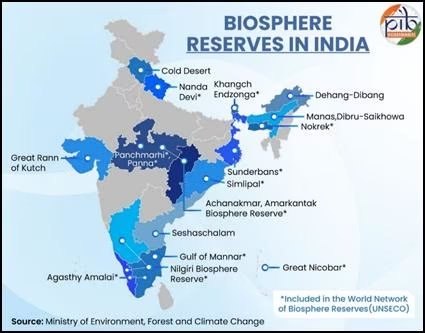
Sustaining Life, Celebrating Nature: India’s Biosphere Reserves
India’s biosphere reserves are celebrated as living laboratories that sustain life and honor nature, especially on the International Day for Biosphere Reserves observed annually on November 3. Here’s a detailed look at how India is embracing and enhancing its biosphere reserves: What Are Biosphere Reserves? - Biosphere reserves are designated areas that balance conservation of biodiversity with sustainable use of natural resources. - They serve as models for harmonious coexistence between people and nature, promoting research, education, and community well-being. India’s Commitment - India has 18 notified biosphere reserves, covering over 91,425 sq. km, with 13 recognized by UNESCO’s World Network of Biosphere Reserves (WNBR). - These reserves span mountains, forests, coasts, and islands, showcasing the country’s ecological diversity and cultural richness. - The Ministry of Environment, Forest, and Climate Change (MoEFCC) oversees a Centrally Sponsored Scheme for Biodiversity Conservation, supporting these reserves under the broader Conservation of Natural Resources and Ecosystems program. Global Recognition - The Cold Desert Biosphere Reserve in Himachal Pradesh was added to UNESCO’s WNBR in September 2025, reinforcing India’s global leadership in biodiversity conservation. - India actively participates in the UNESCO Man and Biosphere (MAB) Programme, aligning national efforts with international frameworks. Purpose and Impact - Biosphere reserves act as platforms for scientific research, environmental monitoring, and sustainable development. - They help preserve ecological and cultural heritage, while empowering local communities through eco-tourism and sustainable livelihoods. Notable Biosphere Reserves Some of the most breathtaking and ecologically rich reserves include: - Nilgiri Biosphere Reserve (Tamil Nadu, Kerala, Karnataka) - Sundarbans Biosphere Reserve (West Bengal) - Gulf of Mannar (Tamil Nadu) - Great Nicobar (Andaman & Nicobar Islands) - Agasthyamalai (Kerala & Tamil Nadu) These reserves are not just conservation zones—they’re vibrant ecosystems where nature and humanity thrive together.
